Author: Jack Inabinet, Bankless; Translator: Tao Zhu, Golden Finance
Each cryptocurrency bull cycle has brought exponential growth, both in terms of value creation and in terms of more and more people believing that they are part of a financial/technological revolution.
Cryptocurrencies have found themselves in direct competition with artificial intelligence to achieve the same bull mark of this cycle, but simply cannot keep up the pace, and despite seemingly high cryptocurrency prices in US dollars, industry sentiment remains depressed.
Unfortunately, While artificial intelligence has almost single-handedly pushed stock indices to all-time highs, troubling warnings continue to suggest that the market is in an unprecedented bubble, and recent signs support the view that the bubble has begun to burst.
The Cryptocurrency Narrative Slows Down
Crypto assets are worth holding largely because of their past performance.
In January, in order to promote its IBIT spot BTC ETF to potential buyers, BlackRock claimed that BTC was the undisputed best performing asset in the past decade, with an annualized return of 10 times that of the stock market index, and investors who held BTC since 2013 have earned a staggering 315,678%!
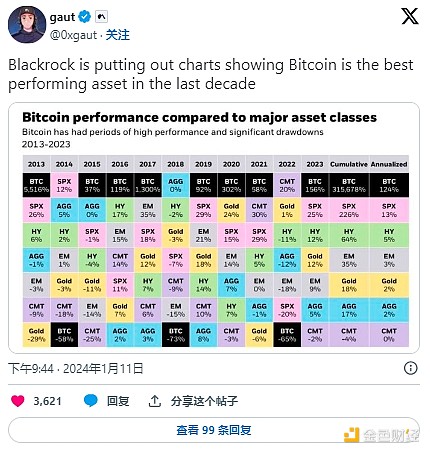
Ethereum surged more than 5,000% in the first six months of 2017 alone, and by January 2018, that figure had reached 17,500%, before the ICO market hit bottom and the crypto industry disappeared from the mainstream market for the next two years.
In 2020, a considerable portion of the monetary stimulus measures designed to combat COVID contraction were poured into crypto assets, leading to inflated valuations. Meanwhile, as economies reopened, 2021 has unsurprisingly seen inflation, increasing the appeal of decentralized cryptocurrencies as a tool to avoid the debasement of fiat currencies.
While crypto assets have once again outperformed many alternative investment classes on a percentage basis this cycle, the industry finds itself taking a backseat to a new investment class that claims to revolutionize humanity: artificial intelligence.
While the broad-cap S&P 500 (SPX) and tech-heavy Nasdaq 100 (NDQ) have been on an almost unstoppable run to new all-time highs, Bitcoin peaked more than four months ago on March 13. Since then, the cryptocurrency market has failed to deliver returns that outperform stocks; even small-cap stocks (RTY) and the equal-weighted S&P 500 (RSP), considered laggards for the major indices in 2024, have been outperforming BTC!
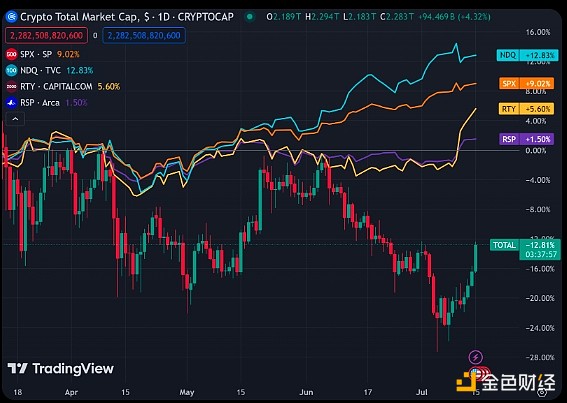
In past cycles, mainstream investors flocked to crypto assets as a bastion of higher returns, but in 2024, the industry has failed to deliver on these promises despite continued large price swings or high volatility.
Here’s the problem: Increased volatility means higher potential investment risk, and investors expect higher returns as compensation for this marginal risk. While BTC and Nvidia have experienced similar volatility, the former has lagged behind by 100% this year.
While cryptocurrencies have been nascent in past cycles, achieving incredible gains despite failing to achieve meaningful adoption, the industry appears to have reached critical mass and must catalyze real-world usage in order to explode.
Bitcoin proponents have long hailed its primary use case as a store of value, yet amid concerns over escalating conflict in the Middle East in April this year, BTC plunged 15% as on-chain investors rejected internet money in favor of “tangible” tokenized gold at premiums of up to 40%!
BTC is not a store of value with the potential to replace gold, but rather a “Veblen good,” a commodity whose demand increases when its price rises.
Plotting BTC/SPX vs. BTC’s relative valuation reveals an extremely strong positive correlation that has persisted since BTC’s inception (i.e., they are essentially the same graph), suggesting that buyers only want BTC during periods of relative strength because they believe they can sell it to someone else at a higher price.
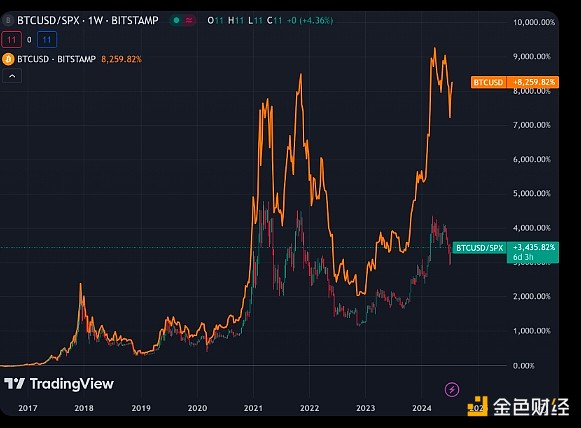
As BTC is currently underperforming AI stocks with a similar level of risk, the likelihood of holders taking profits is increasingly being questioned.
Hard Road Ahead
Actually usable blockchains like Ethereum and Solana aim to foster the next generation of on-chain financial ecosystems.
But in my opinion, smart contract platforms have not made the same leap this cycle, and high-profile consumer-facing innovations have focused on Ponzi-economic point system mechanics and tools to fan meme coin frenzy through celebrity extraction scams. Everything feels different.
Blockchains have undeniable advantages over traditional financial systems, such as higher transaction speeds and innovative composability, but the use of cryptocurrencies for tokenization and payments has failed to gain adoption outside of black market environments, namely for stablecoin payments in jurisdictions such as Argentina, where many forms of USD trading are banned.
While reputable asset managers like BlackRock and Franklin Templeton offer tokenized U.S. Treasury products, the real-world asset sector remains a small player compared to the hundreds of trillions of dollars of global wealth ready to be tokenized.
Just last week, leading multinational investment bank Goldman Sachs announced its intention to delve deeper into tokenization in 2024; a statement that came with the critical caveat that Goldman would operate exclusively on private blockchains.
Cryptocurrencies should be praised for striving to preserve anonymity and privacy, but this model is unworkable for the vast majority of financial system participants and is in clear conflict with nation-states’ desire to understand these systems in order to prevent crime.
The benefits of blockchain are clear, but that doesn’t mean permissionless blockchains will triumph over “legacy” financial systems eager to emulate their strengths.
While it cannot be ignored that hostile regulation has held back the growth of cryptocurrencies, and that global leaders are beginning to take more pro-digital-asset stances, particularly in the United States where the only thing rising faster than AI stocks is the poll numbers of ostensibly pro-crypto Donald Trump, it is worrying that most cryptocurrency use cases have failed to gain free-market adoption.
With crypto assets now an empirically poor investment on a risk-adjusted basis, and the sector failing to gain meaningful traction for existing use cases that could truly spark adoption, it’s no surprise to see the sector’s long-term value proposition increasingly being questioned.
Economic Turbulence Ahead
If cryptocurrencies don’t satisfy our inherent human desire to get rich quick, at least we can always fall back on AI stocks! Right?
AI has replaced cryptocurrencies as the one asset class that must be in an investor’s portfolio, and whether you know it or not, your exposure to the sector is likely very large thanks to the prominence of market-cap-weighted equity indices, which programmatically allocate more exposure to the best-performing constituents.
On July 5, the percentage of S&P 500 stocks that underperformed for 21 consecutive days hit a record high, following weeks of outperformance by high-tech AI leaders. This reveals a huge distortion currently in the market.
Last Thursday, July 11, there was a reversal of fortunes and the pattern seemed to shift, with investors finding a new leader and actively rotating out of large-cap tech stocks and into previously underperforming small-cap stocks.
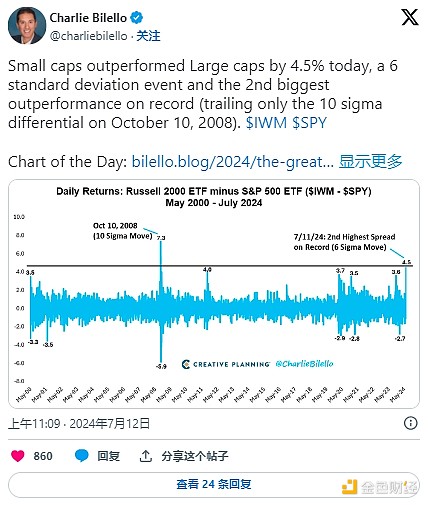
While AI stocks are already generating huge revenues and showing high growth potential, the Cambrian explosion of AI applications will need to continue indefinitely at an unprecedented pace to justify these valuations, and eventually the companies buying hundreds of billions of dollars of hardware to fuel this bubble will need to actually become profitable.
While there is no doubt that AI is valuable and could revolutionize productivity over time, the looming concern remains that investors have already priced in unsustainable levels of growth in related stocks that will not plateau until decades into the future, just as they did during the dot-com bubble.
To highlight the absurdity of the current stock market bubble, the Buffett Indicator — legendary investor Warren Buffett’s preferred value metric that compares U.S. stock market capitalization to GDP — recently hit a modern high of 195%.
Assuming the market capitalization of the top three stocks (Apple, Microsoft, and Nvidia) grows by 15%, and GDP growth is above 3%, the value of these stocks alone will be equal to 107% of U.S. GDP in 10 years, leaving little room for investment in other assets.
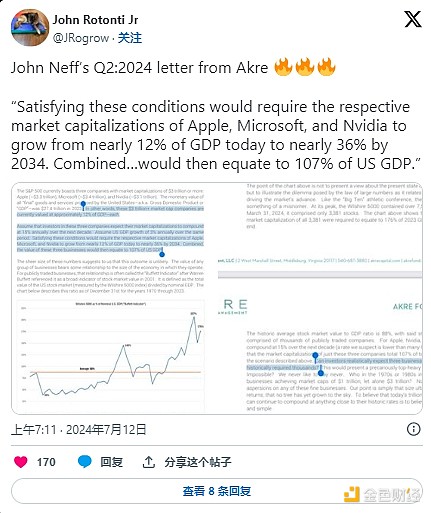
Once the AI supply shock fades and customers begin to realize that they overestimated their demand for AI services, it remains an open question to what extent lofty tech valuations will fall, but given the historic rotation into AI-related stocks last week, the industry's glory days may finally be over.
Excessive asset valuations help increase perceived wealth, allowing individuals to spend more freely, but a stock market pullback could unravel an already troubled global economy.
U.S. consumer inflation, as measured by the CPI, slipped month-over-month into “deflation” territory in June, the first time the index has been negative since the COVID peak in May 2020, while PPI accelerated over the same period, a trend that suggests producers are slashing prices to attract struggling consumers, which could weigh on profitability.
While the biggest risk for many market participants is whether the Federal Reserve will pointlessly adjust its benchmark policy rate by a few percentage points, it’s not hard to foresee a fundamental downside move in a perfectly priced stock market as earnings begin to trend increasingly negative.

The annual decline in full-time employment and the rise in unemployment have triggered the "Sam's Rule", a lagging indicator that has accurately predicted every recession since 1950 with only one false positive.
While the ability to control the price of money itself is certainly powerful, it is unclear how much influence central banks can exert on the economy by artificially manipulating interest rates, which are largely determined by future growth and inflation expectations because their returns are "risk-free".
Rate cuts may be imminent, but it seems unlikely that this so-called panacea will be enough to drive a sustained recovery in the global economy and markets, which are heading for a contraction, as it has failed in past cycles.
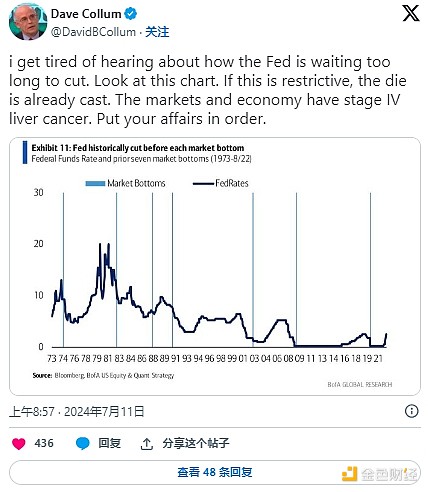
 JinseFinance
JinseFinance








